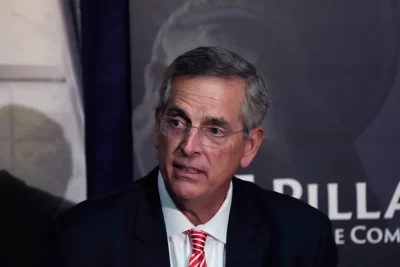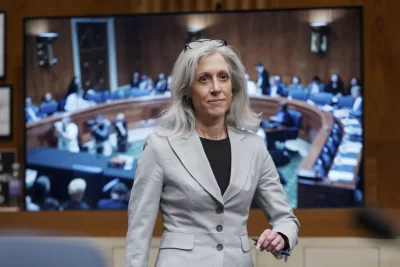VATICAN CITY — Thousands of people filed through the central aisle of St. Peter’s Basilica to pay their final respects to Pope Francis on Wednesday, the start of three days of public viewing ahead of the pontiff’s funeral.
Throngs of ordinary faithful made their way slowly to the 16th-century basilica’s main altar, where Francis’ simple open wooden casket was perched on a slight ramp, as four Swiss Guards stood at attention. Over the coming days, tens of thousands of people are expected to pass through the basilica, which is staying open until midnight to accommodate them.
Many people paying their respects had come to Rome to celebrate Easter, on a spring vacation or other personal business, only to be met with the news of Francis’ death on Easter Monday. Out of devotion to the Argentine pope and his message of inclusion, they joined the procession of mourners that wended through the Holy Door and down the central aisle of the basilica.
Francis was laid out in red robes, clasping a rosary and wearing a bishop’s miter, the traditional pointed headdress. Mourners waited hours to reach the casket — which sat behind a cordon — some holding their cell phones aloft as they neared him to snap photos in what has become a modern ritual.
“It gave me chills,” said Ivenes Bianco, as she left the basilica. She was in Rome from the southern city of Brindisi for medical care, and had come to pay her respects. “He was important to me because he encouraged co-existence. He brought many people together.’’
Cardinals, meanwhile, met in private to finalize preparations for Saturday’s funeral and plan the conclave to elect Francis’ successor.
Francis died on Monday at age 88, capping a 12-year pontificate characterized by his concern for the poor and message of inclusion, but also some criticism from conservatives who sometimes felt alienated by his progressive bent.
Wednesday opened with the bells of St. Peter’s tolling as pallbearers carried Francis’ body from the Vatican hotel where he lived into the basilica in a procession through the same piazza where he had delivered what became his final goodbye. Francis made a surprise popemobile tour through the faithful on Easter Sunday, after being assured by his nurse he could despite his continued frail health from a bout of pneumonia.
Cardinal Kevin Farrell, who is running the Vatican temporarily until a new pope is elected, led the procession down the central aisle to the altar, with clouds of incense preceding him and the choir chanting the Litany of Saints hymn. In pairs, cardinals in red cassocks approached the casket, bowed and made a sign of the cross, followed by small groups of purple-robbed bishops, black-clad ushers, priests and nuns — and then the doors were thrown open to the public.
Heads of state are expected for Francis’ funeral, but the three days of public viewing in the basilica allow ordinary Catholics to grieve the Argentine pope. The viewing ends Friday at 7 p.m., after which Francis’ casket will be closed and sealed.
Simplified rituals reflect Francis’ wishes
Francis’ death and funeral inaugurates a carefully orchestrated period of transition in the 1.4 billion-strong Catholic Church, with cardinals gathering over the coming days before entering into a conclave, the secretive ritual voting in the Sistine Chapel to elect a new pope. There are 135 cardinals under age 80 and eligible to vote, and the new pontiff will likely come from within their ranks. The conclave is not expected to begin before May 5.
South Korean Cardinal Lazarus You Heung-sik, who heads the Vatican’s office for priests, predicted a short conclave, but acknowledged the transition is full of uncertainties.
“We’ll see what the Holy Spirit says,” he said Wednesday. Asked if the next pope could come from Asia, where the Catholic Church is growing, he insisted: “For the Lord, there’s no East or West.”
Papua New Guinea’s first and only cardinal, John Ribat, prepared Wednesday to leave for Rome to participate in the vote, pleased to represent the poor South Pacific island nation of 12 million people and more than 800 languages in a College of Cardinals that Francis greatly diversified over 12 years.




